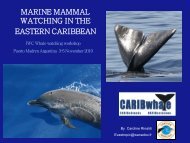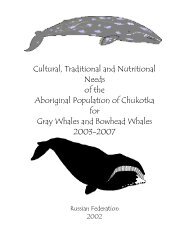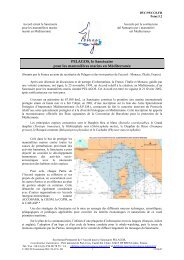Collisions and near miss events between sailing vessels - IWC ...
Collisions and near miss events between sailing vessels - IWC ...
Collisions and near miss events between sailing vessels - IWC ...
Create successful ePaper yourself
Turn your PDF publications into a flip-book with our unique Google optimized e-Paper software.
was defined as a close encounter of a vessel with a cetaceans (animal within 30 metres or less) bearing a<br />
collisions risk but not leading to an impact.<br />
Survey entries <strong>and</strong> internet reports were collected until March 31, 2010. Survey entries that did not yield<br />
useful information were discarded. Where necessary, the following steps were taken to make data<br />
quantifiable: For vessel speed, to receive a conservative value, the lower value of a given range was set as<br />
the travel speed of the vessel. Concerning species identification, the species status was categorized into (1)<br />
definite, when there appeared to be no doubt about the species, sometimes with records of distinctive<br />
morphological features or behaviours of the animals observed, (2) probable, when there was little doubt<br />
about the species identity, sometimes with records of distinctive morphological features or behaviours<br />
observed <strong>and</strong> (3) possible, when there was considerable doubt about the identity of the species. For analysis<br />
by species, only categories (1) <strong>and</strong> (2) were considered. The question regarding <strong>vessels</strong> being “under sail” or<br />
“motoring” sometimes was answered as “motor<strong>sailing</strong>”. These cases were classified as “motoring”.<br />
Evidence of vessel damage was further classified into i) minor, when <strong>sailing</strong> could be continued without<br />
restrictions, ii) major, when <strong>sailing</strong> was only possible in a limited manner <strong>and</strong> iii) vessel loss, when the<br />
vessel finally had to be given up or turned out to be irreparable.<br />
RESULTS<br />
The internet search resulted in 45 reports on collisions <strong>and</strong> two reports of a <strong>near</strong> <strong>miss</strong> event. The online<br />
survey yielded a total of 66 reports on collisions <strong>and</strong> 55 reports of <strong>near</strong> <strong>miss</strong> <strong>events</strong>. Thus, a total of 111<br />
collisions <strong>and</strong> 57 <strong>near</strong> <strong>miss</strong>es were identified.<br />
The temporal distribution of incidents spanned from 1966 until 2010 for collisions <strong>and</strong> from 1979 until 2008<br />
for <strong>near</strong> <strong>miss</strong> <strong>events</strong>. The annual number of reports ranged from 0 to 21 collisions <strong>and</strong> from 0 to 11 <strong>near</strong><br />
<strong>miss</strong> <strong>events</strong>. 72 collisions (75%) occurred in the period from 2002 until 2010 (see Fig. 1).<br />
Fig. 1: Number of reported collisions (N=98) <strong>and</strong> <strong>near</strong> <strong>miss</strong> <strong>events</strong> (N=53) <strong>between</strong> <strong>sailing</strong> <strong>vessels</strong> <strong>and</strong> cetaceans per<br />
year worldwide (1966-2009)<br />
Due to the generic difference of collisions <strong>and</strong> <strong>near</strong> <strong>miss</strong> <strong>events</strong>, especially in light of the dissimilarity of<br />
their outcomes, results will be presented separately here. Percentage numbers mostly refer to the numbers of<br />
cases for which information was available. Accordingly, <strong>miss</strong>ing percentages represent the fraction of<br />
survey entries without answers or where the answer was “Not known”, <strong>and</strong> absent information in internet<br />
reports, respectively.<br />
Near <strong>miss</strong> <strong>events</strong><br />
Out of the total of 57, 55 incidents (96.5%) were reported by sailors directly involved <strong>and</strong> two were found<br />
on the internet. The majority of <strong>near</strong> <strong>miss</strong> <strong>events</strong> occurred in the Atlantic Ocean (N=32; 56.2%), 29 in the<br />
North Atlantic including the Caribbean Sea <strong>and</strong> three in the South Atlantic. 18 incidents were reported for<br />
2






